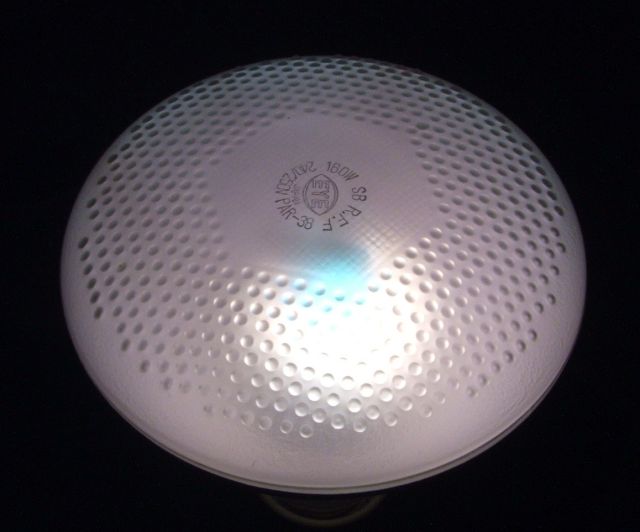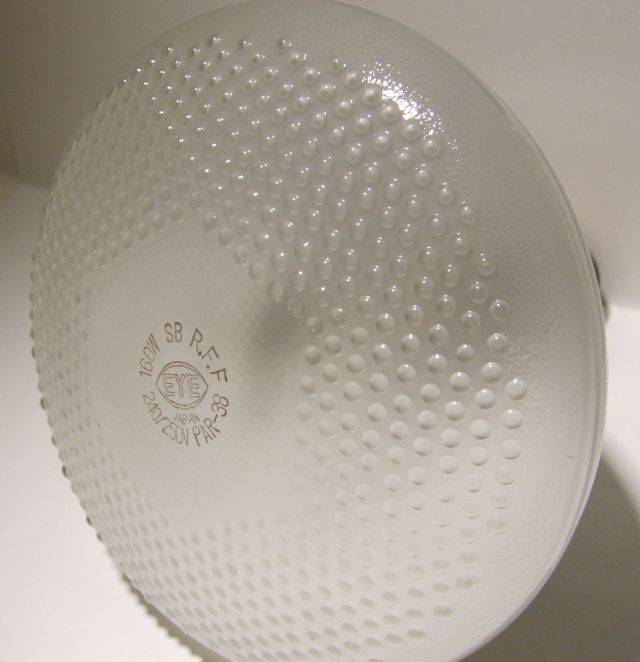
| Manufacturer: | Iwasaki Electric Company. |
| Model: | Eye SB R.F.F. 160W PAR-38. |
| Application: | Industrial. |
| Wattage: | 160W (170W measured). 202W at start up. |
| Diameter (max): | 120mm (BR38 bulb shape). |
| Length: | 149mm. |
| Bulb/Tube material: | Glass, rear aluminium reflector with phosphor coating. Front internally frosted with external dimpled texture. |
| Colour Temperature: | Around 4000K at beam centre. |
| Colour Rendering Index: | Unknown. |
| Peak output wavelength: | N/A |
| Total light output: | 1680Lm (10.5Lm/W) |
| Rated lifetime: | 10'000 Hours. |
| Cap: | E27. |
| Operating voltage: | 240-250V. |
| Operating current: | 730mA. (880mA at start up). |
| Warmup/restrike time: | None. |
| Cost (original): | Unknown. |
| Place of manufacture: | Japan. |
| Date of manufacture: | Unknown. |
| Lamp Status: | Working. |
Blended mercury lamps are almost always seen in the conventional ellipsoidal bulb shapes (well, modern ones anyway), but are also occasionally spotted, albeit in far smaller numbers, in reflector style lamps. This Iwasaki example being one of those lamps. Typically of the Japanese manufacturer, the build of this lamp being virtually perfect in every way. This is mainly due to the fact that the Japanese market is VERY demanding about the quality of their light sources, some of this companies products, in particular their White SON line of products, are almost works of art. The sustained popularity of mercury vapour lighting in Japan and countries of similar climates is mainly down to the preference for high colour temperatures. As a result, the Iwasaki EYE Electric company have still a comprehensive line of mercury vapour products. Such as this one.
There are a variety of different designs seen in reflector style blended lamps, some with clear fronts, some with phosphor coated reflectors, some with frost fronts, some with aluminium reflectors...and all combinations of the above. This particular example has an internally frosted front (complete with dimples on the outer surface). The reflector portion is internally aluminised, and is lightly phosphor coated, in this case, I believe the phosphor material in use to be europium activated yttrium vanadate, as used in most modern fluorescent mercury vapour lamps. I was initially unsure whether a phosphor coating had been used, but examination with a long wave UV source produced the characteristic pink glow, confirming its presence. The use of it in blended lamps is not altogether necessary as the incandescent filament already contributes far more to the output at the red end of the spectrum than any currently produced phosphor is capable of doing. I imagine in this case though it would help to maintain the colour uniformity in the beam, otherwise there would be a chance that despite the frosted front of the lamp, that there could be a distinctly different coloured section to the beam created by the filament and the arc tube.
If the lamp is viewed when run up (though very dark glasses!), it is possible to see the characteristic greenish white colour of the mercury vapour discharge and the yellowish white of the incandescent filament distinctly inside the lamp, as shown by the third picture below. This allows me to gain a little of an insight into the construction of the lamp - which is otherwise a little bit of a mystery thanks to the frosted front, and a very inconsiderately placed mica heat reflective disc in the neck preventing me from being able to see up into it from there...though I guess the fact that it helps prevent lamp holders from getting cooked has to be considered an advantage...Using this method it is possible to see that the filament has been carefully positioned as close as possible to the centre of the arc tube, again to provide as good mixing of the light from the two sources.
Technologically this is a relatively conventional high pressure blended mercury vapour lamp. Unfortunately, this means that the usual efficacy reducing compromises have been made. Specifically a relatively high gas filling pressure has to be used to prevent rapid evaporation of the filament material. While the mercury discharge will operate most efficiently with a low gas fill pressure to allow greater thermal insulation - additionally nitrogen must be used as it is able to withstand the strong electrical fields present inside the lamp without breaking down. Unfortunately, this does have a strong negative effect on the efficacy of the lamp, this example being only able to manage an efficacy of 10.5 Lm/W - worse than many incandescent lamps can now manage. Despite the low efficacy offered by these lamps, they do still have the advantage of long service lives (rated to 10'000 hours, but often actually surviving for considerably longer), which makes them ideally suited to applications where access is not easy for lamp replacement. Another advantage of this type of lamp compared to virtually all other discharge lamps, is that it gives instant bright light the moment power is applied - in fact having a slightly unusual characteristic in that the lamp starts out far brighter than it is when fully run up. Initially appearing just as a high power incandescent lamp, with the output gradually dimming slightly, and the colour temperature increasing considerably as the arc tube warms up, the amount of light given out by that increasing, and the filament dimming until a constant light level is reached.
These are lamps that are getting more scarce now, especially the reflector style such as this, so it's good to have one here. I happen to particularly like the light produced by these lamps - and if it weren't for replacements being so hard to source these days, I would probably put one of these into service in here.

Iwasaki Eye SB R.F.F. 160W PAR-38 Blended Mercury Lamp - General overview of lamp

Iwasaki Eye SB R.F.F. 160W PAR-38 Blended Mercury Lamp - Detail of lamp cap

Iwasaki Eye SB R.F.F. 160W PAR-38 Blended Mercury Lamp Illuminating my workstation from a distance of approximately two metres

Iwasaki Eye SB R.F.F. 160W PAR-38 Blended Mercury Lamp - Overview of lamp while alight

Iwasaki Eye SB R.F.F. 160W PAR-38 Blended Mercury Lamp - Detail of lamp while lit where both mercury and incandescent sources are visible

Iwasaki Eye SB R.F.F. 160W PAR-38 Blended Mercury Lamp - Overview of lamp packaging

Iwasaki Eye SB R.F.F. 160W PAR-38 Blended Mercury Lamp - Detail of front of lamp showing dimpled texture

Iwasaki Eye SB R.F.F. 160W PAR-38 Blended Mercury Lamp - Displayed next to a ruler to show size of the lamp

Iwasaki Eye SB R.F.F. 160W PAR-38 Blended Mercury Lamp Output Spectra

Iwasaki Eye SB R.F.F. 160W PAR-38 Blended Mercury Lamp - Detail of lamp etch
This lamp added to the Virtual Display Shelf on the 22nd April 2006 at 23:59.
References: Manufacturers datasheets. Some additional information (specifically the bit on phosphors) from the excellent lighting website Lamptech.
Acknowledgements: Many thanks to the website visitor who donated this lamp (both of them!) for exhibition!
This page last updated:
16th June 2023: Made page formatting changes to improve readability on mobile devices. Also made some background changes to improve search engine behaviour.